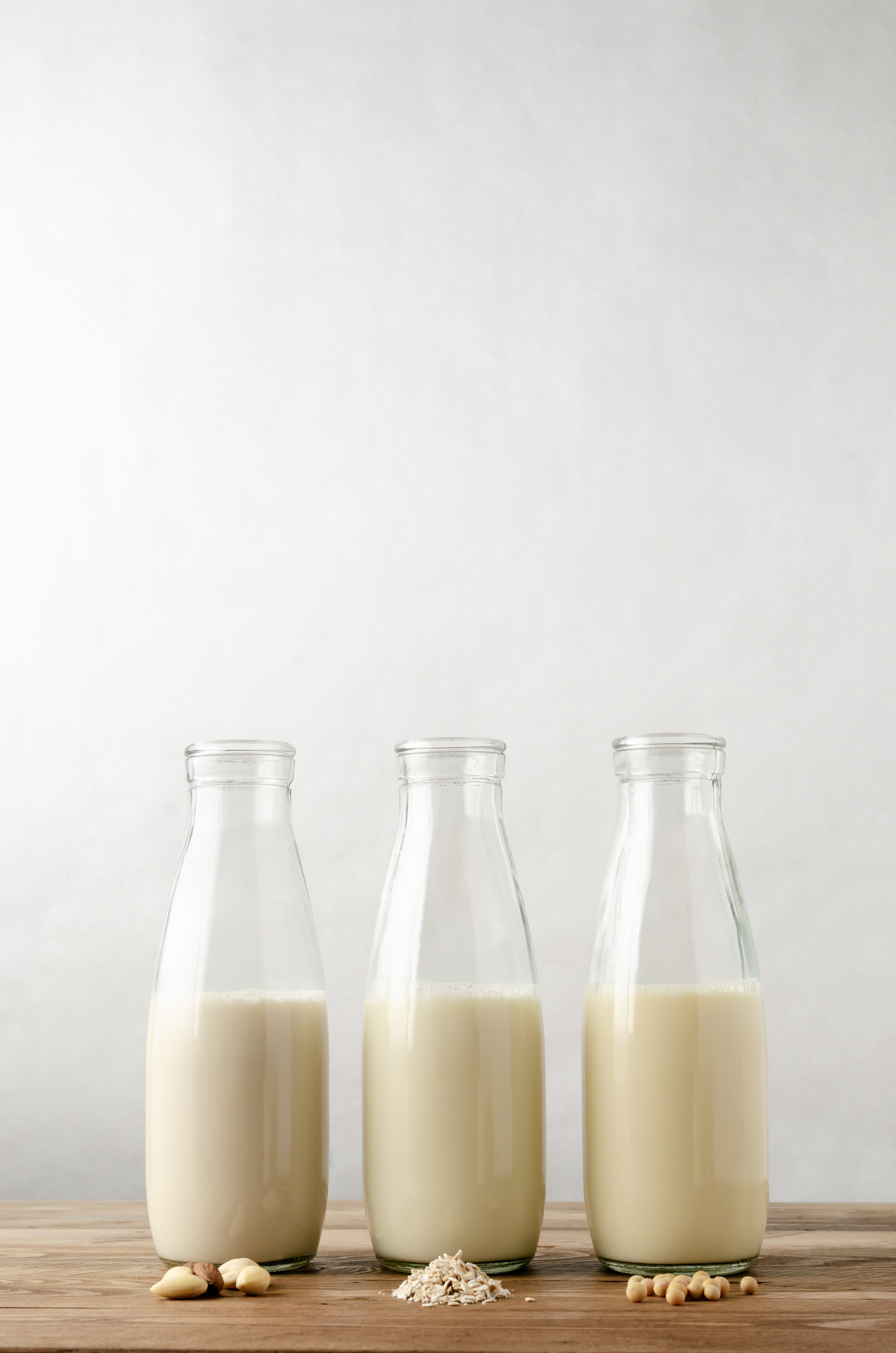Article co-authored with Maggie Goodall.
When it comes to your child, worries of osteoporosis and poor bone health may feel like a lifetime away, but throughout childhood and adolescence is the best time to prevent this pernicious disease. Dense bones are strong bones and increasing bone density becomes more challenging once adulthood is reached. By the age of 18–20, 90 percent of the bone mass we will have for the rest of our lives has already been acquired so it’s important to do what we can to increase the quality and density of bone while it is being built, making childhood the perfect time to start. A balanced diet and physical activity are primary cornerstones of most health issues, but for bone health, the application of these in childhood requires a bit more nuance than you might think.
Non-dairy foods are also rich in calcium
Calcium-rich foods come to mind when many of us think of “bone foods,” and for good reason. Over 99 percent of the body’s calcium is stored in the bones and teeth, and it plays a principal role in bone density. Unsurprisingly, children with low-calcium diets have been shown to have bones that are less dense than those consuming adequate amounts.1,2
Although high calcium foods are key to supporting bone health, we need to consider the sources we once turned to uncritically. We’ve grown up with the idea that dairy products are the go-to group for high calcium foods, but this idea is falling more and more out of favour. In fact, recent studies have shown that daily intake of milk may increase the risk of some cancers.3 While the USDA’s dietary guidelines include dairy as essential for healthy eating, Canada’s food guide has specifically excluded dairy as a required food group in their updated version. If dairy as a required food group is being challenged, it raises the question: where do we get our calcium?
Calcium is abundant in many non-dairy sources. One literature review looked at several studies that compared bone mineral density in those who consumed soy protein versus those who consumed animal protein and found no difference in bone mineral density between the two groups.4 Similarly, another study looked at children who consumed 1500 mg of dairy per day versus children who consumed 1000 mg of other calcium sources, and found that the dairy intervention had no effect on bone mineral acquisition or body composition.5
What is plant-based milk?
Plant-based milks may seem like the next best thing to replace dairy, especially as plant-based milks are often fortified with calcium during production. While it’s possible that adequate calcium levels could be achieved by providing these milks to children, they come with their own set of concerns. With plant-based milks, it’s important to do your homework to know exactly what you’re getting.
Almond Milk
Almond milk is a common choice for non-dairy milk, however, it’s riddled with other concerns. Almonds require almost a gallon of water per almond to produce, are typically grown in areas prone to drought, and cultivation is usually dependent on large amounts of pesticides. Many commercial almond milks also contain carrageenan, an additive commonly used as a thickening and emulsifying agent, which has vigorously conflicting studies regarding its safety.
Rice Milk
Rice milk can be a source of arsenic, with some countries not recommending consumption in those under 4.5 years old.
Soy Milk
Soy milk can affect hormones in both children and adults, and has been linked to developmental changes in children.
Oat Milk
Oat milk is a fairly new player on the dairy substitute field that has fewer concerns than other options and can be made at home. Note that if being consumed as a source of dairy, opt for a fortified commercial brand.
If you and your family have chosen not to consume dairy milk and deem it necessary to consume an alternative as a source of calcium, it may be best to rotate the options.
Happily, there is a huge variety of tasty, family-friendly, calcium-rich foods in other areas of the grocery store besides the dairy (or dairy alternatives) section. An advantage to using whole foods to provide calcium is that they contain a variety of other vitamins and minerals, many of which are also crucial in building strong bones. With so many foods providing calcium and micronutrients, and with so many ways to prepare them, finding calcium-rich foods that fit into your child’s diet shouldn’t be a challenge!

Lean Green Calcium-Rich Machines
Finding ways to regularly include some of these heavy hitters in your family’s diet can make sure appropriate calcium levels are being achieved without the excessive reliance on dairy.
Leafy Greens
Leafy greens, whether served raw, cooked, or blended into sauces, smoothies, or soups, are an easy and versatile way to add a high dose of calcium to the diet. Some greens, including collard, kale, and especially spinach, contain high amounts of oxalates, a natural compound that can interfere with the body’s ability to absorb minerals, including calcium, but they’re still worth consuming for the nutrient and fibre content and even for the smaller calcium content that will get through. Incorporating a variety of different greens will ensure that your child is getting the most calcium bang for the buck!
Nuts
Nuts are typically kid-friendly (once kids are past the choking risk—around age four) and an easy way to encourage calcium intake. Almonds pack the most calcium in their tiny packages, while hazelnuts are a notable second. Grind into butter, and spread away on fruits and veggies, or add to smoothies, dips, and sauces!
Sesame Seeds
Sesame seeds blended into butters or tahini aren’t just yummy, they’re chock full of calcium. So sprinkle or drizzle away and incorporate into sauces, dressings, and even sweet treats!
Legumes
Legumes are calcium-rich, protein-packed powerhouses that can be added to any meal. Or dab on a dollop of hummus which is a double whammy of chickpeas and tahini!
Tofu
Tofu comes in many varieties, and the amount of calcium can vary as some manufacturers add additional calcium to their product (called calcium-set tofu). Firm tofu is suited for grilling, baking, or frying, making a great meat replacement, and holds up easily to a number of cooking techniques. Silken tofu is very soft, makes a great egg replacement, and can be blended into smoothies, spreads, dips, and sauces.
Vegetables
Vegetables, like broccoli, contain a goodly amount of calcium, but preparation is everything! Raw, roasted, and steamed are all great options, while boiling is less ideal, as the process can remove a significant portion of a vegetable’s mineral content.
Fruits
Fruits can also help make a small contribution to your child’s daily calcium intake. Fresh oranges, dried figs, and raisins have higher amounts of calcium than other fruit. Keep an eye on portion size, as dried fruit often contains substantial amounts of sugar.

Supplements for bone health
Calcium can’t do it alone! It needs a little help from key micronutrients to support strong and healthy bone maintenance.
Vitamin D
Vitamin D plays a vital role in bone health, both by increasing the absorption of calcium in the digestive tract, and ensuring that it is directed to the bones rather than building up in other places. Because sunshine exposure is tricky to negotiate—depending on where you live and the problems of over or underexposure—the most reliable source of vitamin D is through supplementation.
Vitamin K
Vitamin K works alongside vitamin D to keep bones strong, and those with higher blood levels of vitamin K have been shown to have denser bones than those with lower levels.6 Vitamin K is conveniently found in leafy greens, broccoli, and other cruciferous veggies.
Magnesium
Magnesium is important in converting supplemented vitamin D into a form that is usable by the body, indirectly affecting calcium absorption. It also helps to suppress the release of PTH (a hormone that draws calcium out of bones) while increasing the release of calcitonin (a hormone that enables bones to absorb calcium). Magnesium is found in leafy greens, cruciferous vegetables, many nuts and seeds, and legumes.
Zinc
Zinc stimulates osteoblasts (the cells that make bone) and inhibits osteoclasts (cells that break down bone). Legumes, meat products, and nuts are all great sources of zinc.
Phosphorus
Phosphorus is a crucial player in the maintenance of healthy bones, but it can also impair the ability to effectively store calcium in the bone when its levels are excessively high. Since phosphorus is present in many foods we eat, such as meat and dairy, and is a commonly used additive in processed foods, high phosphorus levels are typically the result of a diet of excess.
Protein
Protein is essential to both muscle and bone strength. The stronger our muscles are, the more resistance they apply to bone, which in turn makes our bones stronger. Protein intake is also a very efficient way to keep kids satiated, which helps maintain appropriate body mass and reduce the risk of obesity, another risk factor for osteoporosis. Legumes, nuts, leafy greens, poultry, fish, and meat are superstar sources of protein.
THROW ME A BONE!
One of the best steps we can take is to encourage exercise. Not only does exercise promote overall physical and mental health, during childhood it has been linked to stronger, denser bones later in life. But not all forms of exercise are equal when it comes to increasing bone density. The development of bone is triggered when it is subjected to impact, making high impact exercises like running, jumping, boxing, and cross training, much more effective in building strong bones than low impact activities, like swimming, biking, or yoga. One study showed an increase in upper leg and lower back bone density in children who repeatedly jump off of two-foot boxes over the course of a few months.7 Sports and activities that incorporate jumping, such as basketball and dance, are great options, as are less rule-based activities like setting up obstacle courses at home to encourage movement. Further, promoting unstructured outdoor play where kids have a chance to explore their environment without direction not only has immense benefits for developing confidence and independence, but can encourage bone-building exercise as well, particularly if there are opportunities for climbing and jumping. Starting this type of activity early creates lasting impacts: highly active 5-year-olds showed improved bone density over their less-active peers up to six years in the future, even if physical activity was not sustained over this time.
Chronic psychological stress is also a risk factor for osteoporosis due to its negative effects on the brain, immune, and endocrine systems. The activation of maladaptive pathways suppresses and alters the expression of hormones and increases inflammation, which can lead to bone loss by inhibiting the formation and absorption of bone tissue. Psychological stress is also a risk factor for mental health disorders, which are correlated with osteoporosis. One study showed that those who suffered from depression or anxiety had lower bone mineral density, likely due to inflammation associated with mental health conditions. The good news is that vigorous, weight-bearing activity both builds bones and reduces stress—an excellent double whammy! Kids can also benefit greatly from other strategies of stress management, including mindfulness practices, creative outlets, and spending time outside.
Osteoporosis prevention starts in childhood. By encouraging and creating space for our kids to exercise daily—which has the added and important benefit of supporting mental health and reducing stress—and especially by offering a healthy, varied diet, we can help them maintain bone health for years to come.
You may also enjoy: Natural Treatment Plan for Healthy Bones, Nutrients that Help with Calcium Absorption, and Collagen Supplements for Superior Skin and Bones.
For references visit ecoparent.ca/extras/FALL20.






